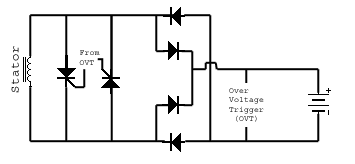| Author | Message | ||
Natexlh1000 |
I was thinking (I know, stoppit!) anyways, The voltage regulator shunts extra current to ground in order to maintain the same voltage output, right? hat must mean that the regulator does less when there is more load? Also, that must mean the the alternator puts out maximum current all the time, right? | ||
99x1 |
Warning: The following is based my understanding of the alternator, and may or may not be correct! "...voltage regulator shunts extra current to ground...right?" Nope, the voltage regulator shorts the output of the stator - neither stator wire is grounded and will cause problems if they do go to ground. "...must mean the regulator does less when there is more load?" The regulator (SCRs) do less when there is more load, but the rectifier portion (diodes) of the module does more (voltage drops across 2 diodes), so it will still run hot (maybe hotter - SCR's latch to low resistance?). "...the alternator puts out maximum current all the time, right?" (Alternator commonly refers to the whole thing, I think you meant stator) Sort of - the stator windings have resistance and when the regulator shunts the stator, the internal copper losses go up by the square of the current (I2R loss). As well, at ~3600 RPM the stator's iron core saturates, so the current output rises and then flattens out. (looking sort of like a dyno torque curve). The rated 22 amp max output is at 3600 RPM. I don't think it is quite as simple as the circuit diagram would suggest.  | ||
Fullpower |
nate: you are correct in that the stator runs at full output at all times. also correct in that all wasted power is converted efficiently to heat in the voltage regulator. running additional electrical accesories, such as lights, grip heaters, electric vest reduces the waste heat in the voltage regulator. I live and ride in Alaska. ride at night a lot. my 1998 sportster has its original regulator, after 40,000 miles. more then half of these miles were run with an electric vest, and grip heaters and a 100 watt hi beam.after 5 years i gave the original battery to a friend who ran it in his BMW, so I am running the second battery now, no charge problems, but i did the preventive maintenance procedure of removing, glass-bead blasting, and installing a ground lead to the OEM regulator.this assures a good ground path, so no stray electrons get lost. | ||
Natexlh1000 |
Good to know. I know on my ironhead that an increase of electrical load will eat the brushed on the generator faster. I just wanted to get a "feel" for what's up with our new-fangled charging systems. Essentially, I could run it at near-full power output without really beating on my bike eh? | ||
Fullpower |
yes, affirmative | ||
Blake |
Please post topics like this to the applicable topic in the Knowledge Vault. We'll be moving this one there soon. Thanks for helping to get BadWeB organized.  172689 |